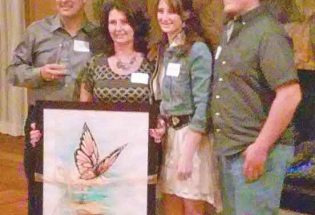
Photo by Terry Georgia
Miles McGaughey of Mountain Warrior Honey removes a honeycomb from inside the walls of the historic Foursquare Gospel Church on Mountain Avenue as he works to move a large bee colony from the church.
By Terry Georgia
The Surveyor
It was Memorial Day. While most of Berthoud celebrated with family picnics and solemn tributes to heroes who had died for our country, Cathy and Tom Leston awaited the arrival of a different sort of hero, one who would help them solve a growing problem deep inside the walls of their beloved historic church.
For the last two years, Cathy and Tom have cleaned and helped out around the Foursquare Gospel Church at 500 Mountain Ave. The church has been a notable landmark on Berthoud’s main street since it was built in 1904. Its lovely interior is simple, still filled with the original oak pews, hand-tooled woodwork and more than ten beautiful stained glass windows which paint the interior with golden light throughout the day.
Unfortunately, time and nature have conspired to wear down parts of the stately Romanesque and Gothic Revival building, which has been on the Colorado State Register of Historic Properties since 2001. Antique plumbing, missing mortar, peeling paint and dozens of other signs of constant use and deterioration have plagued the beautiful building over many decades.
Pastor Esteban Salazar, known as “Pastor Steve,” has been serving the church and its small community since 1989. Among all the other structural problems throughout the building, about ten years ago Pastor Steve noticed some bees finding their way inside. For a while he chalked it up to open doors and windows as congregants moved in and out for various church activities. But it wasn’t that simple.
It was Cathy Leston who grew concerned as she cleaned the building. As she swept, she was finding a growing number of dead and dying honeybees on the floor of the narrow balcony that encircles most of the sanctuary. Many of them seemed to fall near the stained glass windows in the northwest corner. Outside, just above a north window, there was mortar missing between several bricks. Dozens of bees could be seen flying in and out of the gaps. It was clear they had made a home for themselves inside the walls of the church.
In recent months Leston was sweeping up 100 to 200 bees every week. Many of them decapitated. She knew honeybees were in trouble everywhere, so she did some research and learned that wasps and hornets often decapitate honeybees to kill them. She, her husband Tom and Pastor Steve assumed there was an active bee colony inside the walls and they were worried that the colony was threatened. They agreed it was time to take action to protect the bees and the historic building.
For four months Leston reached out to bee experts, bee keepers and anyone she could find that might be able to help. “I didn’t want the bees fumigated,” she explained, “I wanted someone to move them to a new home outside the church.” Call after call, Leston was turned down. “When I described the situation,” she recalled, “some said they didn’t want to work so high off the ground, many said they didn’t want to work on an historic building. Most wouldn’t even come out and look at it.” Then, just as they thought they’d never find anyone willing to move the bees, they found Miles McGaughey.
A colorful character who owns Mountain Warrior Honey in Longmont, McGaughey has been fascinated with bees most of his life and has been relocating hives and swarms since the 1980’s. Recently he was extracting bee colonies from inside Old Main, the oldest building on the University of Colorado’s Boulder campus. He’s taken on difficult extractions before and he was willing to help Berthoud Foursquare too. He wanted to save the colony.
McGaughey arrived at the church on Memorial Day to do one final assessment of the situation and locate the best spot to begin his search for the queen, because her location dictates the activity of the hive. Clad in a well-worn khaki jumpsuit with a large bee embroidered on the chest and a mesh hood draped down his back, McGaughey hauled ladders, tools and homemade gadgets up the stairs and onto the interior balcony. Knowing the hive had been inside the wall for well over a decade, McGaughey first tried to pinpoint the location with an infrared device, designed to find a heat signature from the colony. He thought a dark stain and crack in the plaster above the stained glass window, might be a honey stain, indicating the hive was nearby. “If I told you I had a plan, I’d be lying,” McGaughey joked, “every one of these situations is different. “My plan — [he paused for dramatic effect] is to get them out.”
He used a stethoscope to listen to the walls, straining to hear the low hum created by thousands of bees at work. Even with decades of experience and high-tech gear, there was no way to truly know exactly where the hive was without drilling into the wall. The first test hole yielded nothing. The second, just above it, was also empty. Cutting a larger hole for a better view, McGaughey could see a large void between the sturdy support beams used in early 1900’s construction. On the fifth try, lower on the wall and on the other side of the beam, the drill bit came out with honey on it. A bee followed. He’d found the hive, and the bees were not happy about it. Even standing several feet away, everyone could hear the intense buzz coming from behind the wall. Outside, the bees were aggressively buzzing in and out between the bricks, trying to assess the threat.
Inside, McGaughey had put a piece of tape over the hole and was thinking about how best to proceed. He would need to locate the brood nest, also called the nucleus hive, where the queen bee would be actively laying eggs. Removing that part of the hive guaranteed the rest of the bees would follow. “They’re like buffalo,” McGaughey said, preparing to cut into the wall, “you can herd them wherever they want to go. Is it too late to tell you I’m allergic to bees stings?” he laughed. His Epi-pen was “somewhere in my truck. “I don’t get stung often, but when I do, every place I’ve been stung before burns.” He didn’t seem phased.
Over the years McGaughey has had adventures extracting hives and moving swarms. He moved four different hives from inside the walls of the Brighton Armory when it was being converted into a community center. And once, he removed a large hive from Longmont’s historic Callahan House while guests were arriving for a wedding in the garden. He managed to get the bees out just before the bride and groom arrived, but as he was leaving, his truck caught fire in the driveway. “I had bees in the back and fire in the front,” remembered McGaughey, “I managed to get the fire out and push the truck down the street before the bride and groom got there. In the end the bees were okay and the folks at Callahan House ended up putting the honey from those hives in little jars to give to couples who got married there, so it all turned out fine.”
At the Foursquare Church he covered his work area with heavy plastic, stapling himself inside. He sawed a hole in the wall about 12 inches high and 10 inches wide, revealing a set of honeycombs that appeared to line up like books on a shelf. He carefully removed the pieces, some empty and dark with age, others with honey sealed safely into the cells. Some of the combs were wrapped around sticks, others warped into odd shapes to fit into whatever space was available. He found remnants of a wasp’s nest. He also discovered a small protrusion from one of the combs, the shape of a cocoon. He said it was a new queen, ready to emerge. The hive was about a week away from splitting into two colonies, one staying in the original hive, the other “swarming” off to find a new location. It could have presented a real problem if the swarm had found another spot in the church.
After clearing these combs, McGaughey could see that the hive continued higher into the wall cavity. It would take more time to find the queen. He would have to return again the next morning. In the meantime, the bees continued their work, collecting pollen and protecting their queen.
On day two, McGaughey “smoked” the bees before cutting a larger hole in the wall. “They think they’re living in a tree,” he explained, “and the smoke makes them think the tree is on fire, so they eat as much honey as they can in case they have to move out quickly. When they’re full of honey, it’s like we feel after Thanksgiving dinner, they’re stuffed and they’re moving slowly, so they’re lethargic.” Smoke makes the bees less likely to go after McGaughey as he get’s closer to the queen.
The second cut revealed an area teeming with thousands of bees. McGaughey figured there were about 40 to 70 thousand in the hive and most were residing in this part of the wall. He had readied a white plastic crate, in which he’d place the nucleus hive with the queen, but first, he had to deal with the tens of thousands of bees crawling on the combs. Enter the bee vacuum.
McGaughey’s handmade vacuum consisted of a large plastic water bottle, the kind used on a typical water cooler. On the flat end he’d attached the body of a small hand vacuum, at the spout, he’d duct-taped a long rubber hose. There was a shoulder strap for easy carrying. For over an hour McGaughey gently vacuumed thousands of bees into the water jug, eventually clearing the hive enough to continue removing large chunks of the comb.
Several hours later, the queen’s brooding nest was tucked safely in it’s new box and placed near the open window. With a “flight hole” open at one end, McGaughey explained that the bees in the box could still come and go, because many would be returning to the hive after long trips foraging for food. In the meantime, he would use an intense-smelling liquid called “Bee Gone” inside the wall, to discourage the bees from returning there. Instead, they’d follow the queen’s scent to find her in the box. Later that night, he’d return and take the box to his Longmont home, where he has about 70 other bee colonies under his care. There, he’d reunite the queen with her vacuumed subjects.
McGaughey said he’ll keep this colony in his “medicine yard,” a space near the house where he can watch them carefully to ensure they are settling into their new location. He’ll know by next spring whether the move was fully successful. He has no reason to believe they won’t acclimate to their new surroundings. “They need to spend the winter cuddled with their honey.,” he quipped.
At Foursquare Church, the holes in the walls will remain open for another week or so, allowing scavenger bees to completely clear out anything left over inside the wall. After that, the church will be able to patch the wall inside and out to prevent another colony from moving in.
The church is planning some fundraisers to try to raise about $500 to cover the costs of the removal and patching. With only 30 adult members in the congregation, fundraising can be a challenge.
Miles McGaughey had one last piece of advice for anyone wanting to help bee populations everywhere: “We need more people like the ones at this church who care enough to move a hive instead of exterminating them.,” he said, “But really, it’s not what you do, it’s what you don’t do. Don’t use pesticides! Colorado has 1,500 native pollinators. Killing any of them is a threat to them all.” He urges everyone to learn more about the plants and pollinators around them because often, what people see as disease on a plant is really just bees trying to live. Plants and pollinators can live in harmony, but only if people don’t poison them first.
Anyone needing help with a hive or interested in learning more about bees can contact Miles McGaughey at [email protected]. Anyone wanting to help Foursquare Gospel Church pay for the repairs and bee removal can contact Pastor Steve Salazar: [email protected].
- April, 12 2018

- August, 01 2017

- May, 18 2017

Turner students re-enact “Trial of th...
Scott Washenfelder’s sixth grade literature classes...
- January, 19 2017

Berthoud Parks and Recreation Christm...
The Berthoud Parks and Recreation Department held a Christmas Coloring Contest for kids in grades...
- January, 15 2015

Sabadoses are Citizens of the Year
Special to the Surveyor Citizens of the Year: Dave and Julia...
- July, 30 2020

Suicides in Larimer County last year ...
By Amber McIver-Traywick The Surveyor Suicide continues to be a major concern in Larimer County....

POLICEBLOTTER
Community News
Northern Water sets C-BT quota at 70% for 2024
Community News

Emotions run high during Revere Property hearing
Community News
Snowpack at 119% above normal
Community News

Karspeck to serve third term as Berthoud mayor
Community News

OPINION – No bitchin’ allowed
Community News
Roy Tripi to become principal of BHS on July 1
Community News
COMMUNITY CALENDAR:
Community Calendar – add an event
Homestead Fine Art Gallery First Fridays OPEN HOUSE
03 May 4:00 PM - 7:00 PM
Homestead Fine Art Gallery First Fridays OPEN HOUSE
07 Jun 4:00 PM - 7:00 PM
Homestead Fine Art Gallery First Fridays OPEN HOUSE
05 Jul 4:00 PM - 7:00 PM
Homestead Fine Art Gallery First Fridays OPEN HOUSE
02 Aug 4:00 PM - 7:00 PM
Homestead Fine Art Gallery First Fridays OPEN HOUSE
06 Sep 4:00 PM - 7:00 PM
Homestead Fine Art Gallery First Fridays OPEN HOUSE
04 Oct 4:00 PM - 7:00 PM

